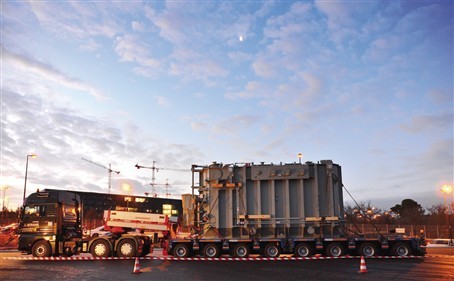First Heavy Exceptional Load arrives to ITER


The size, weight and dimensions of ITER components vary tremendously. Some of them are small and compact and can be delivered through the normal route to Cadarache with no specific traffic protocols. Others, due to their voluminous exceptional weight and size, will need to be transported at night, along a specific route, and accompanied by the forces of the gendarmarie so as to minimise any disturbance that may be caused to locals. These are classified as Heavy Exceptional Loads (HELs) in the ITER jargon.
With two successful convoy rehearsals already conducted during the last two years for the transportation of “exceptional loads”, carried out by DAHER in collaboration with F4E, ITER International Organization (IO), Agence ITER France and the French local authorities, the arrival of the first real “exceptional load” was an important achievement for all parties.
An 87-tonne high voltage transformer procured by the US and manufactured by Korea’s Hyundai Heavy Industry plant, made history by crossing the ITER gates around 4:30 a.m. on Wednesday 14 January. The component travelled by sea for roughly one month and was then transported along 104 km from the port of Marseille to the ITER construction site in Cadarache. 120 people were mobilised for this operation and all aspects worked out smoothly without any glitch.
In line with the spirit of collaboration that underpins the international energy project, this exercise has been possible thanks to the financial support offered by F4E to ITER IO and all Domestic Agencies which is expected to reach 70 million EUR for the transport of HELs. This operation is expected to be replicated 220 times so that DAs transport their heavy exceptional loads from the port of Marseille to ITER.
Click here to watch the clip on the trip of this component.